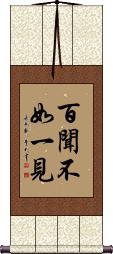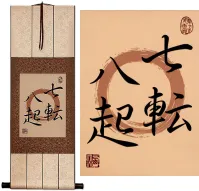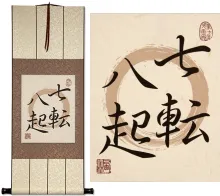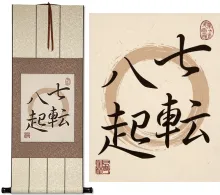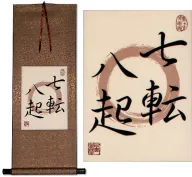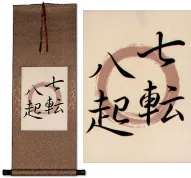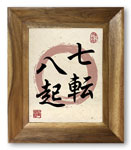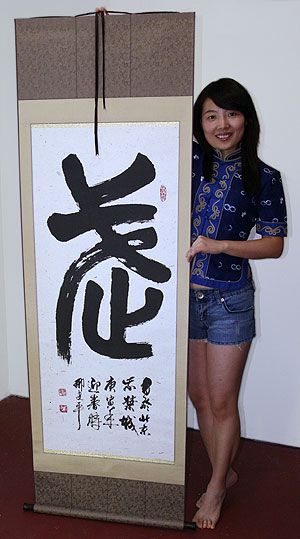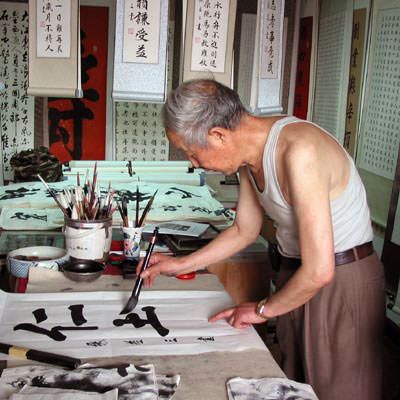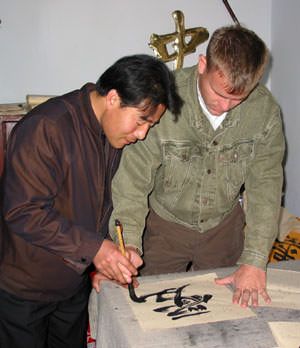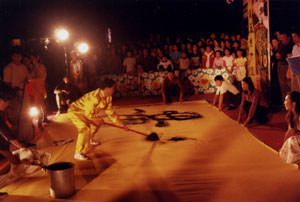Many custom options...
And formats...

Seven Times Down Eight Times Up in Chinese / Japanese...
Buy a Seven Times Down Eight Times Up calligraphy wall scroll here!
Personalize your custom “Seven Times Down Eight Times Up” project by clicking the button next to your favorite “Seven Times Down Eight Times Up” title below...
Fall Down Seven Times, Get Up Eight
Always rising after a fall or repeated failures
七転八起 is a Japanese proverb that relays the vicissitudes of life, with the meaning “seven times down eight times up.”
Some would more naturally translate it into English as “Always rising after a fall or repeated failures” or compare it to the English, “If at first, you don't succeed, try, try again.”
The first Kanji is literally “7.” The second means “fall down” (sometimes this Kanji means “turn around,” “revolve” or “turn over” but in this case, it holds the meaning of “fall”). The third is “8.” And the last is “get up,” “rouse,” or “rise.”
Basically, if you fail 7 times, you should recover from those events and be prepared to rise an 8th time. This also applies if it is the world or circumstances that knock you down seven times...
...just remember that you have the ability to bounce back from any kind of adversity.
Note: This can be pronounced in two ways. One is “shichi ten hakki” or “shichitenhakki.” The other is “nana korobi ya oki” also written, “nanakorobi-yaoki.”
Special Note: The second character is a Kanji that is not used in China. Therefore, please select a Japanese calligrapher for this title.
Hearing a Hundred Times is Not as Good as Seeing Once
百聞不如一見 is a Chinese proverb that means “Seeing once is better than hearing one hundred times” which is similar to the idea of “Seeing is believing.”
You can also get the idea, “Seeing for oneself is better than hearing from many others.”
If you break it down directly, you get “100 hears/listens (is) not as-good (as) one sight.”
Broken Mirror Rejoined
Used in modern times for divorced couples that come back together
破鏡重圓 is about a husband and wife who were separated and reunited.
About 1500 years ago in China, there lived a beautiful princess named Le Chang. She and her husband Xu De Yan loved each other very much. But when the army of the Sui Dynasty was about to attack their kingdom, disposed of all of their worldly possessions and prepared to flee into exile.
They knew that in the chaos, they might lose track of each other, so the one possession they kept was a bronze mirror which is a symbol of unity for a husband and wife. They broke the mirror into two pieces, and each of them kept half of the mirror. They decided that if separated, they would try to meet at the fair during the 15th day of the first lunar month (which is the lantern festival). Unfortunately, the occupation was brutal, and the princess was forced to become the mistress of the new commissioner of the territory, Yang Su.
At the Lantern Festival the next year, the husband came to the fair to search for his wife. He carried with him his half of the mirror. As he walked through the fair, he saw the other half of the mirror for sale at a junk market by a servant of the commissioner. The husband recognized his wife's half of the mirror immediately, and tears rolled down his face as he was told by the servant about the bitter and loveless life that the princess had endured.
As his tears dripped onto the mirror, the husband scratched a poem into his wife's half of the mirror:
You left me with the severed mirror,
The mirror has returned, but absent are you,
As I gaze in the mirror, I seek your face,
I see the moon, but as for you, I see not a trace.
The servant brought the inscribed half of the mirror back to the princess. For many days, the princess could not stop crying when she found that her husband was alive and still loved her.
Commissioner Yang Su, becoming aware of this saga, realized that he could never obtain the princess's love. He sent for the husband and allowed them to reunite.
This proverb, 破鏡重圓, is now used to describe a couple who has been torn apart for some reason (usually divorce) but have come back together (or remarried).
It seems to be more common these days in America for divorced couples to reconcile and get married to each other again. This will be a great gift if you know someone who is about to remarry their ex.
Mark the boat to find the lost sword / Ignoring the changing circumstances of the world
刻舟求劍 is an originally-Chinese proverb that serves as a warning to people that things are always in a state of change.
Thus, you must consider that and not depend on the old ways or a way that may have worked in the past but is no longer valid.
This idiom/proverb comes from the following story:
A man was traveling in a ferry boat across a river. With him, he carried a treasured sword. Along the way, the man became overwhelmed and intoxicated by the beautiful view and accidentally dropped his prized sword into the river. Thinking quickly, he pulled out a knife and marked on the rail of the boat where exactly he had lost his sword.
When the boat arrived on the other side of the river, the man jumped out of the boat and searched for his sword right under where he'd made the mark. Of course, the boat had moved a great distance since he made the mark, and thus, he could not find the sword.
While this man may seem foolhardy, we must take a great lesson from this parable: Circumstances change, so one should use methods to handle the change. In modern China, this is used in business to mean that one should not depend on old business models for a changing market.
This proverb dates back to the Spring and Autumn period (770–476 BC) of the territory now known as China. It has spread and is somewhat known in Japan and Korea.
This in-stock artwork might be what you are looking for, and ships right away...
Gallery Price: $100.00
Your Price: $49.88
Gallery Price: $100.00
Your Price: $58.88
Gallery Price: $100.00
Your Price: $58.88
Gallery Price: $162.00
Your Price: $89.88
Gallery Price: $162.00
Your Price: $89.88
Gallery Price: $100.00
Your Price: $39.88
Gallery Price: $100.00
Your Price: $39.88
Gallery Price: $100.00
Your Price: $49.88
Gallery Price: $89.00
Your Price: $49.00
Gallery Price: $100.00
Your Price: $49.88
Gallery Price: $222.00
Your Price: $122.88
Gallery Price: $222.00
Your Price: $122.88
Not the results for seven times down eight times up that you were looking for?
Below are some entries from our dictionary that may match your seven times down eight times up search...
| Characters If shown, 2nd row is Simp. Chinese |
Pronunciation Romanization |
Simple Dictionary Definition |
壮 see styles |
yuuki / yuki ゆうき |
(noun or adjectival noun) (1) vibrancy; strength; bravery; manliness; (noun or adjectival noun) (2) (esp. of men) one's prime (approx. age 30); (counter) (3) (also 草) counter for times of moxibustion; (personal name) Yūki |
傳承 传承 see styles |
chuán chéng chuan2 cheng2 ch`uan ch`eng chuan cheng |
More info & calligraphy: Smriti |
列子 see styles |
liè zǐ lie4 zi3 lieh tzu retsuko れつこ |
More info & calligraphy: Liezi(female given name) Retsuko |
司徒 see styles |
sī tú si1 tu2 ssu t`u ssu tu shito しと |
More info & calligraphy: Stu(hist) (See 六卿) Minister of Civil Administration and Social Welfare (Zhou dynasty China) |
拉丁 see styles |
lā dīng la1 ding1 la ting raten らてん |
More info & calligraphy: Ladin(1) (abbreviation) (kana only) Latin (language); (can act as adjective) (2) (abbreviation) (kana only) Latin-American; Latin; Latino; (3) (kana only) Latin; Roman; relating to the literature, culture, etc. of ancient Rome |
武術 武术 see styles |
wǔ shù wu3 shu4 wu shu bujutsu ぶじゅつ |
More info & calligraphy: Martial Arts / Wushu(1) martial arts; military arts; (2) (See 武術太極拳) wushu (Chinese martial art) |
泰晤士 see styles |
tài wù shì tai4 wu4 shi4 t`ai wu shih tai wu shih |
More info & calligraphy: Thames |
菩提樹 菩提树 see styles |
pú tí shù pu2 ti2 shu4 p`u t`i shu pu ti shu bodaiju; bodaiju ぼだいじゅ; ボダイジュ |
More info & calligraphy: The Tree of Enlightenment / The Bodhi Tree(1) Tilia miqueliana (species of linden tree); (2) (See インドボダイジュ) sacred fig (Ficus religiosa); bodhi tree; bo tree; peepal tree; pipal tree; (given name) Bodaiju bodhidruma, bodhitaru, bodhivṛkṣa; the wisdom-tree, i.e. that under which Śākyamuni attained his enlightenment, and became Buddha. The Ficus religiosa is the pippala, or aśvattha, wrongly identified by Faxian as the palm-tree; it is described as an evergreen, to have been 400 feet high, been cut down several times, but in the Tang dynasty still to be 40 or 50 feet high. A branch of it is said to have been sent by Aśoka to Ceylon, from which sprang the celebrated Bo-tree still flourishing there. |
風雲児 see styles |
fuuunji / fuunji ふううんじ |
More info & calligraphy: Soldier of Fortune |
ジャスト see styles |
jasuto ジャスト |
More info & calligraphy: Justo |
天下太平 see styles |
tiān xià tài píng tian1 xia4 tai4 ping2 t`ien hsia t`ai p`ing tien hsia tai ping tenkataihei / tenkataihe てんかたいへい |
More info & calligraphy: The Whole World at Peace(expression) (yoji) peaceful and tranquil (uneventful); peace reigns over the land; halcyon times of peace |
失意泰然 see styles |
shitsuitaizen しついたいぜん |
More info & calligraphy: Keep Calm in Face of Adversity |
波に乗る see styles |
namininoru なみにのる |
More info & calligraphy: Go With The Flow |
百聞不如一見 百闻不如一见 see styles |
bǎi wén bù rú yī jiàn bai3 wen2 bu4 ru2 yi1 jian4 pai wen pu ju i chien |
More info & calligraphy: Seeing is Believing |
仞 see styles |
rèn ren4 jen jin じん |
unit of length used in ancient times, equal to 7 or 8 Chinese feet 尺[chi3] ren (ancient Chinese measure of height, depth, etc.; between 1-3 meters) |
伎 see styles |
jì ji4 chi takumi たくみ |
artistry; talent; skill; (in ancient times) female entertainer (irregular kanji usage) technique; art; skill; (personal name) Takumi Skill; 伎巧; 伎藝. |
倍 see styles |
bèi bei4 pei bai ばい |
(two, three etc) -fold; times (multiplier); double; to increase or multiply (noun - becomes adjective with の) (1) double; twice (as much); (counter) (2) times (as much); -fold; (counter) (3) (e.g. 40倍 = 1 in 40) 1-nth; 1 to n; 1 in n; (surname) Bai Double, double-fold, a fold; to turn from or against, to revolt. |
匴 see styles |
suǎn suan3 suan |
bamboo utensil used for washing rice in ancient times; bamboo container for a hat used in the capping ceremony 冠禮|冠礼[guan4 li3] in ancient times |
古 see styles |
gǔ gu3 ku furuhama ふるはま |
ancient; old; paleo- (1) used item; secondhand item; (prefix noun) (2) old; used; previous; antiquity; ancient times; (surname) Furuhama Ancient, antique, old; of old. |
尹 see styles |
yǐn yin3 yin in いん |
(literary) to administer; to govern; (bound form) governor; prefect; magistrate (official title in imperial times) (hist) (See 弾正台・1) director (of the ritsuryō-period Imperial Prosecuting and Investigating Office); (surname) Wan |
岔 see styles |
chà cha4 ch`a cha |
fork in road; bifurcation; branch in road, river, mountain range etc; to branch off; to turn off; to diverge; to stray (from the path); to change the subject; to interrupt; to stagger (times) |
府 see styles |
fǔ fu3 fu fu ふ |
seat of government; government repository (archive); official residence; mansion; presidential palace; (honorific) Your home; prefecture (from Tang to Qing times) (1) (urban) prefecture (i.e. Osaka and Kyoto); (2) centre (e.g. of learning); center; seat; (3) (government) office; (4) (hist) fu (administrative unit in China, Korea and Vietnam); (surname) Futaka |
弁 see styles |
biàn bian4 pien wakachi わかち |
(old) cap (garment); military officer of low rank (in former times); preceding (1) speech; tongue; talk; eloquence; (suffix noun) (2) dialect; brogue; accent; (3) (abbreviation) bento; Japanese box lunch; (4) petal; (noun - becomes adjective with の) (5) valve; (6) Oversight Department; division of the daijokan under the ritsuryo system responsible for controlling central and provincial governmental offices; (given name) Wakachi |
微 see styles |
wēi wei1 wei bi び |
tiny; miniature; slightly; profound; abtruse; to decline; one millionth part of; micro-; Taiwan pr. [wei2] (noun or adjectival noun) (1) minuteness; (numeric) (2) one millionth; (female given name) Honoka sūkṣma. Minute, small, slight; abstruse, subtle; disguised; not; used in the sense of a molecule seven times larger than 極微 an atom; translit. vi, bi. |
懸 悬 see styles |
xuán xuan2 hsüan kakeru かける |
to hang or suspend; to worry; public announcement; unresolved; baseless; without foundation (suf,adj-no) (1) -clad; (2) (kana only) in the midst of; (3) tenths (e.g. wholesale price, as tenths of retail price); (4) times (i.e. multiplied by); (5) able-to-seat (of a chair, etc.); (1) (abbreviation) credit; (2) money owed on an account; bill; (3) (abbreviation) (kana only) hot noodles in broth; (n,n-suf) (4) proportion (of wholesale price, as tenths of list price); (suffix) (5) in the midst of; (6) rest; rack; hanger; (personal name) Kakeru Suspend, hang. |
挨 see styles |
ái ai2 ai |
to suffer; to endure; to pull through (hard times); to delay; to stall; to play for time; to dawdle |
掛 挂 see styles |
guà gua4 kua kake かけ |
to hang; to suspend (from a hook etc); to hang up (the phone); (of a line) to be dead; to be worried; to be concerned; (dialect) to make a phone call; to register (at a hospital); to make an appointment (with a doctor); (slang) to kill; to die; to be finished; to fail (an exam); classifier for sets or clusters of objects (suf,adj-no) (1) -clad; (2) (kana only) in the midst of; (3) tenths (e.g. wholesale price, as tenths of retail price); (4) times (i.e. multiplied by); (5) able-to-seat (of a chair, etc.); (suffix) charge; duty; person in charge; official; clerk; (1) (abbreviation) credit; (2) money owed on an account; bill; (3) (abbreviation) (kana only) hot noodles in broth; (n,n-suf) (4) proportion (of wholesale price, as tenths of list price); (suffix) (5) in the midst of; (6) rest; rack; hanger; (surname) Kake To hang, suspend. |
攺 see styles |
yǐ yi3 i |
a kind of metal or jade ornament worn in ancient times to ward off evil spirits |
旗 see styles |
qí qi2 ch`i chi hata はた |
banner; flag; (in Qing times) Manchu (cf. 八旗[Ba1 qi2]); administrative subdivision in inner Mongolia equivalent to 縣|县[xian4] county; CL:面[mian4] flag; (surname) Hata |
旧 see styles |
kyuu / kyu きゅう |
(prefix) (1) old; former; ex-; (2) the old; old things; old customs; (3) old times; bygone days; (n,pref) (4) (abbreviation) (See 旧暦) Japan's old (lunisolar) calendar |
Click here for more seven times down eight times up results from our dictionary
The following table may be helpful for those studying Chinese or Japanese...
| Title | Characters | Romaji (Romanized Japanese) | Various forms of Romanized Chinese | |
| Fall Down Seven Times, Get Up Eight | 七転八起 | shichi ten hakki / nana korobi ya oki shichi ten haki / nana korobi ya oki | ||
| Hearing a Hundred Times is Not as Good as Seeing Once | 百聞不如一見 百闻不如一见 | bǎi wén bù rú yī jiàn bai3 wen2 bu4 ru2 yi1 jian4 bai wen bu ru yi jian baiwenburuyijian | pai wen pu ju i chien paiwenpujuichien |
|
| Broken Mirror Rejoined | 破鏡重圓 破镜重圆 | pò jìng chóng yuán po4 jing4 chong2 yuan2 po jing chong yuan pojingchongyuan | p`o ching ch`ung yüan pochingchungyüan po ching chung yüan |
|
| Mark the boat to find the lost sword Ignoring the changing circumstances of the world | 刻舟求劍 刻舟求剑 | kokushuukyuuken kokushukyuken | kè zhōu qiú jiàn ke4 zhou1 qiu2 jian4 ke zhou qiu jian kezhouqiujian | k`o chou ch`iu chien kochouchiuchien ko chou chiu chien |
| In some entries above you will see that characters have different versions above and below a line. In these cases, the characters above the line are Traditional Chinese, while the ones below are Simplified Chinese. | ||||
Successful Chinese Character and Japanese Kanji calligraphy searches within the last few hours...

